Impacts of Energy Storage System on Power System Reliability: A Systematic Review
Abstract
1. Introduction
2. Review Methodology
3. Descriptive Analysis of Literature
3.1. Publication Trend, Year, Publications, and Authors
3.2. Empirical Data: Geographical and Power System Network Distributions
3.3. Overview of Power System Reliability and Energy Storage Systems
4. Analysis of Energy Storage Utilization in Improving Power System Reliability
4.1. Categorisation of Energy Storage Implementations
4.2. Energy Storage Technologies
4.2.1. Battery Energy Storage System
4.2.2. Pumped Hydro Energy Storage
4.2.3. Hydrogen-Based Fuel Cells
4.2.4. Compressed Air Energy Storage (CAES)
4.3. Energy Storage Resources
4.3.1. Conventional Energy
4.3.2. Renewable Energies
4.4. Energy Storage Utilization in Improving Power System Reliability
4.4.1. Hierarchical Level 1
4.4.2. Hierarchical Level 2
4.4.3. Hierarchical Level 3
5. Conclusions
5.1. Synthesis of Findings
5.2. Limitations of Current Study and Avenues for Future Research
Author Contributions
Acknowledgments
Conflicts of Interest
Appendix A
| No. | Title | Authors | Type of ESS |
|---|---|---|---|
| 1. | Reliability Evaluation of the Solar Power System Based on the Markov Chain Method | L. Wu, C. Wen, H. Ren (2017) | Battery |
| 2. | Robust Optimization based Energy Dispatch in Smart Grids Considering Simultaneously Multiple Uncertainties: Load Demands and Energy Prices | M. Nassourou, V. Puig, J. Blesa (2017) | Battery |
| 3. | Tactical and Operational Management of Wind Energy Systems with Storage using a Probabilistic Forecast of the Energy Resource | C. Azcárate, F. Mallor, P. Mateo (2016) | Hydrogen-based FC |
| 4. | Optimal Planning of Battery Energy Storage Considering Reliability Benefit and Operation Strategy in Active Distribution System | W. Liu, S. Niu, H. Xu (2016) | Battery |
| 5. | A Probabilistic Method Combining Electrical Energy Storage and Real-Time Thermal Ratings to Defer Network Reinforcement | D.M. Greenwood, N.S. Wade, P.C. Taylor, P. Papadopoulos, N. Heyward (2017) | Battery |
| 6. | Reliability Studies of Modern Distribution Systems Integrated With Renewable Generation and Parking Lots | H. Farzin, M. Fotuhi-Firuzabad, M. Moeini-Aghtaie (2016) | EV battery |
| 7. | Reliability Evaluation of Tidal and Wind Power Generation System with Battery Energy Storage | M. Liu, W. Li, J. Yu, Z. Ren, R. Xu (2016) | Battery |
| 8. | Maiden application of Cuckoo Search Algorithm for Optimal Sizing of a Remote Hybrid Renewable Energy System | S. Sanajaoba, E. Fernandez(2016) | Battery |
| 9. | Storage-Reserve Sizing with Qualified Reliability for Connected High Renewable Penetration Micro-Grid | J. Dong, F. Gao, X. Guan, Q. Zhai, J. Wu (2015) | Battery |
| 10. | Reliability Contribution Function considering Wind Turbine Generators and Battery Energy Storage System in Power System | U. Oh, J. Choi, H.-H. Kim (2016) | Battery |
| 11. | Operational Adequacy Studies of a PV-based and Energy Storage Stand-Alone Microgrid | L.H. Koh, P. Wang, F.H. Choo, K.-J. Tseng, Z. Gao, H.B. Püttgen (2015) | Battery |
| 12. | Optimal Integration of Mobile Battery Energy Storage in Distribution System with Renewables | Y. Zheng, Z. Dong, S. Huang, K. Meng, F. Luo, J. Huang, D. Hill (2015) | Battery |
| 13. | Evaluation of Reliability Parameters in Micro-Grid | H. Hassanzadeh Fard, S.A. Bahreyni, R. Dashti, H.A. Shayanfar (2015) | Battery |
| 14. | Optimal ESS Allocation for Load Management Application | A.S.A. Awad, T.H.M. El-Fouly, M.M.A. Salama (2013) | Battery |
| 15. | A Wind-battery Optimal Design Algorithm for Power Generation System | K.M. Kamble, H.T. Jadhav (2015) | Battery |
| 16. | Stochastic Performance Assessment and Sizing for a Hybrid Power System of Solar/Wind/Energy Storage | A. Arabali, M. Ghofrani, M. Etezadi-Amoli, M.S. Fadali (2014) | Battery |
| 17. | Optimal Operation Strategy of Energy Storage System for Grid-Connected Wind Power Plants | Z. Shu, P. Jirutitijaroen (2013) | CAES |
| 18. | Optimal Planning of Stand-Alone Micro-Grids Incorporating Reliability | C. Wang, B. Jiao, L. Guo, K. Yuan, B. Sun (2014) | Battery |
| 19. | Optimal Sizing of a Stand-alone Photovoltaic System Using Statistical Approach | S. Fezai, J. Belhadj (2014) | Battery |
| 20. | Reliability Assessment in Smart Distribution Networks | H. Guo, V. Levi, M. Buhari (2013) | Battery |
| 21. | Adequacy and Economy Analysis of Distribution Systems Integrated with Electric Energy Storage and Renewable Energy Resources | Y. Xu, C. Singh (2012) | Battery |
| 21. | Adequacy and Economy Analysis of Distribution Systems Integrated with Electric Energy Storage and Renewable Energy Resources | Y. Xu, C. Singh (2012) | Battery |
| 22. | Reliability Modeling and Control Schemes of Composite Energy Storage and Wind Generation System with Adequate Transmission Upgrades | Y. Zhang, S. Zhu, A.A. Chowdhury (2011) | Battery |
| 23. | Reliability Evaluation Considering Wind and Hydro Power Coordination | R. Karki, P. Hu, R. Billinton (2010) | PHES |
| 24. | Evaluation of Different Operating Strategies in Small Stand-Alone Power Systems | Bagen, R. Billinton (2005) | Battery |
| 25. | Weather Data and Probability Analysis of Hybrid Photovoltaic-Wind Power Generation Systems in Hong Kong | H.X. Yang, L. Lu, J. Burnett (2003) | Battery |
| 26. | Probabilistic Production Costing of Diesel–Wind Energy Conversion Systems | S.H. Karaki, R.B. Chedid, R. Ramadan (2000) | Battery |
| 27. | Power System Reliability Impact of Energy Storage Integration With Intelligent Operation Strategy | Y. Xu, C. Singh (2014) | Battery |
| 28. | A New Bi-Objective Approach to Energy Management in Distribution Networks with Energy Storage Systems | A. Azizivahed, E. Naderi, H. Narimani, M. Fathi, M.R. Narimani (2018) | Battery |
| 29. | Stochastic Capacity Expansion Planning of Remote Microgrids with Wind Farms and Energy Storage | E. Hajipour, M. Bozorg, M. Fotuhi-Firuzabad (2015) | Battery |
| 30. | Expansion Planning of Active Distribution Networks with Centralized and Distributed Energy Storage Systems | X. Shen, M. Shahidehpour, Y. Han, S. Zhu, J. Zheng (2017) | Battery |
| 31. | On the Use of Pumped Storage for Wind Energy Maximization in Transmission-Constrained Power Systems | M. A. Hozouri, A. Abbaspour, M. Fotuhi-Firuzabad, M. Moeini-Aghtaie (2015) | PHES |
| 32. | Reliability-Constrained Optimal Sizing of Energy Storage System in a Microgrid | S. Bahramirad, W. Reder, A. Khodaei (2012) | Battery |
| 33. | Operation Scheduling for an Energy Storage System Considering Reliability and Aging | W.W Kim, J.S. Shin, S.Y. Kim, J.O. Kim (2017) | Battery |
| 34. | Cooperative Energy Dispatch for Multiple Autonomous Micro-Grids with Distributed Renewable Sources and Storages | X. Fang, S. Ma, Q. Yang, J. Zhang (2016) | Battery |
| 35. | An Efficient Cost–Reliability Optimization Model for Optimal Siting and Sizing of Energy Storage System in a Micro-Grid in the Presence of Responsible Load Management | S. Nojavan, M. Majidi, N.N. Esfetanaj (2017) | Battery |
| 36. | Reliability Improvement in Radial Electrical Distribution Network by Optimal Planning of Energy Storage Systems | H. Saboori, R. Hemmati, M.A. Jirdehi (2015) | Battery |
| 37. | Reducing Uncertainty Accumulation in Wind-Integrated Electrical Grid | T.C. Hung, J. Chong, K.Y. Chan (2017) | Battery |
| 38. | Stochastic Scheduling of Local Distribution Systems Considering High Penetration of Plug-In Electric Vehicles and Renewable Energy Sources | S. Tabatabaee, S.S. Mortazavi, T. Niknam (2017) | EV Battery |
| 39. | Reliability/Cost-Based Multi-Objective Pareto Optimal Design of Stand-Alone Wind/PV/FC Generation Micro-Grid System | H.R. Baghaee, M. Mirsalim, G.B. Gharehpetian, H.A. Talebi (2016) | Hydrogen-based FC |
| 40. | Stochastic-Based Resource Expansion Planning for a Grid-Connected Micro-Grid using Interval Linear Programming | M.H.S. Boloukat, A.A. Foroud (2016) | Battery |
| 41. | Trends of Changes in the Power Generation System Structure and Their Impact on the System Reliability | A. Rusin, A. Wojaczek (2015) | PHES |
| 42. | Multistage Generation Expansion Planning Incorporating Large Scale Energy Storage Systems and Environmental Pollution | R. Hemmati, H. Saboori, M.A. Jirdehi (2016) | Battery |
| 43. | DG Mix, Reactive Sources, and Energy Storage Units for Optimizing Microgrid Reliability and Supply Security | S. A. Arefifar, Y.A.R.I. Mohamed (2014) | Battery |
| 44. | Energy Storage Application for Performance Enhancement of Wind Integration | M. Ghofrani, A. Arabali, M. Etezadi-Amoli, M.S. Fadali (2013) | CAES |
| 45. | Impacts of Energy Storage on Power System Reliability Performance | Bagen, R. Billinton (2005) | Battery |
| 46. | Reliability Evaluation of a Solar Photovoltaic System with and without Battery Storage | S. S. Singh, E. Fernandez (2015) | Battery |
| 47. | Impact of Pumped Storage on Power Systems with Increasing Wind Penetration | A. Tuohy, M. O’Malley (2009) | PHES |
| 48. | Reliability Evaluation of a Wind–Diesel Hybrid Power System with Battery Bank Using Discrete Wind Speed Frame Analysis | X. Liu, S. Islam (2006) | Battery |
| 49. | Impacts of Energy Storage on Reliability of Power Systems with WTGs | Z.Y. Gao, P. Wang, J. Wang (2010) | Battery |
| 50. | Method for Evaluating Battery Size based on Loss of Load Probability Concept for a Remote PV system | S.S. Singh, E. Fernandez (2014) | Battery |
| 51. | Incorporating Well-Being Considerations in Generating Systems Using Energy Storage | Bagen, R. Billinton (2005) | Battery |
| 52. | Power System Reliability Assessment With Electric Vehicle Integration Using Battery Exchange Mode | L. Cheng, Y. Chang, J. Lin, C. Singh (2008) | EV battery |
| 53. | Reliability Cost/Worth Associated With Wind Energy and Energy Storage Utilization in Electric Power Systems | B. Bagen, R. Billinton (2008) | Battery |
| 54. | Microgrid Reliability Evaluation with Renewable Distributed Generation and Storage Systems | C.L.T. Borges, E. Cantarino (2011) | Battery |
| RefID | Does the Paper Provide Successful Outcomes? | Does the Paper State any Constraint? | Does the Paper Provide Adequate Outcome Data? | Does the Paper Provide Future Avenues? | Total |
|---|---|---|---|---|---|
| 8 | YES | YES | YES | NO | 3 |
| 22 | YES | YES | YES | YES | 4 |
| 29 | YES | YES | YES | NO | 3 |
| 30 | YES | YES | YES | YES | 4 |
| 34 | YES | YES | YES | YES | 4 |
| 36 | YES | YES | YES | NO | 3 |
| 46 | YES | YES | YES | NO | 3 |
| 47 | YES | YES | YES | NO | 2 |
| 55 | YES | YES | YES | YES | 5 |
| 64 | YES | YES | YES | NO | 3 |
| 73 | YES | YES | YES | NO | 3 |
| 77 | YES | YES | YES | NO | 3 |
| 80 | YES | YES | YES | NO | 3 |
| 81 | YES | YES | YES | YES | 4 |
| 87 | YES | YES | YES | NO | 3 |
| 101 | YES | YES | YES | NO | 3 |
| 106 | YES | YES | YES | YES | 4 |
| 111 | YES | YES | YES | YES | 4 |
| 125 | YES | YES | YES | YES | 4 |
| 136 | YES | YES | YES | YES | 4 |
| 153 | YES | YES | YES | NO | 3 |
| 159 | YES | YES | YES | NO | 4 |
| 169 | YES | YES | YES | NO | 4 |
| 206 | YES | YES | YES | NO | 4 |
| 216 | YES | YES | YES | YES | 4 |
| 226 | YES | YES | YES | NO | 3 |
| 242 | YES | YES | YES | YES | 4 |
| 246 | YES | YES | YES | NO | 3 |
| 267 | YES | YES | YES | YES | 4 |
| 274 | YES | YES | YES | YES | 4 |
| 282 | YES | YES | YES | NO | 3 |
| 286 | YES | YES | YES | NO | 3 |
| 307 | YES | YES | YES | NO | 4 |
| 318 | YES | YES | YES | NO | 3 |
| 323 | YES | YES | YES | NO | 3 |
| 328 | YES | YES | YES | NO | 3 |
| 330 | YES | YES | YES | YES | 4 |
| 357 | YES | YES | YES | NO | 3 |
| 359 | YES | YES | YES | YES | 4 |
| 361 | YES | YES | YES | NO | 3 |
| 362 | YES | YES | YES | NO | 3 |
| 387 | YES | YES | YES | NO | 3 |
| 442 | YES | YES | YES | NO | 3 |
| 455 | YES | YES | YES | NO | 3 |
| 462 | YES | YES | YES | NO | 3 |
| 463 | YES | YES | YES | NO | 3 |
| 465 | YES | YES | YES | NO | 3 |
| 466 | YES | YES | YES | YES | 4 |
| 467 | YES | YES | YES | YES | 4 |
| 469 | YES | YES | YES | NO | 3 |
| 470 | YES | YES | YES | NO | 3 |
| 473 | YES | YES | YES | NO | 3 |
| 474 | YES | YES | YES | NO | 3 |
| 477 | YES | YES | YES | NO | 3 |
References
- Billinton, R.; Allan, R.N.; Salvaderi, L. Applied Reliability Assessment in Electric Power Systems; IEEE: Piscataway Township, NJ, USA, 1991. [Google Scholar]
- Sekhar, P.C.; Deshpande, R.; Sankar, V. Evaluation and improvement of reliability indices of electrical power distribution system. In Proceedings of the 2016 National Power Systems Conference (NPSC), Bhubaneswar, India, 19–21 December 2016; pp. 1–6. [Google Scholar]
- Farrokhabadi, M.; Solanki, B.V.; Canizares, C.A.; Bhattacharya, K.; Koenig, S.; Sauter, P.S.; Leibfried, T.; Hohmann, S. Energy storage in microgrids: Compensating for generation and demand fluctuations while providing ancillary services. IEEE Power Energy Mag. 2017, 15, 81–91. [Google Scholar] [CrossRef]
- Zhang, Y.; Gevorgian, V.; Wang, C.; Lei, X.; Chou, E.; Yang, R.; Li, Q.; Jiang, L. Grid-level application of electrical energy storage: Example use cases in the United States and China. IEEE Power Energy Mag. 2017, 15, 51–58. [Google Scholar] [CrossRef]
- Moher, D.; Shamseer, L.; Clarke, M.; Ghersi, D.; Liberati, A.; Petticrew, M.; Shekelle, P.; Stewart, L.A. Preferred reporting items for systematic review and meta-analysis protocols (PRISMA-P) 2015 statement. Syst. Rev. 2015, 4. [Google Scholar] [CrossRef] [PubMed]
- Kirkham, J.J.; Altman, D.G.; Williamson, P.R. Bias due to changes in specified outcomes during the systematic review process. PLoS ONE 2010, 5, e9810. [Google Scholar] [CrossRef] [PubMed]
- Kirkham, J.J.; Dwan, K.M.; Altman, D.G.; Gamble, C.; Dodd, S.; Smyth, R.; Williamson, P.R. The impact of outcome reporting bias in randomised controlled trials on a cohort of systematic reviews. Br. Med. J. 2010, 340, c365. [Google Scholar] [CrossRef] [PubMed]
- Shamseer, L.; Moher, D.; Clarke, M.; Ghersi, D.; Liberati, A.; Petticrew, M.; Shekelle, P.; Stewart, L.A. Preferred reporting items for systematic review and meta-analysis protocols (PRISMA-P) 2015: Elaboration and explanation. Br. Med. J. 2015, 349, g7647. [Google Scholar] [CrossRef] [PubMed]
- Denyer, D.; Tranfield, D. Producing a systematic review. In The Sage Handbook of Organizational Research Methods; Sage Publications Ltd.: Thousand Oaks, CA, USA, 2009. [Google Scholar]
- Baker, J.; Collinson, A. Electrical energy storage at the turn of the millennium. Power Eng. J. 1999, 13, 107–112. [Google Scholar] [CrossRef]
- Fink, A. Conducting Research Literature Reviews: From the Internet to Paper; Sage: Thousand Oaks, CA, USA, 2005. [Google Scholar]
- Dugan, R.C.; Taylor, J.A.; Montenegro, D. Energy storage modeling for distribution planning. IEEE Trans. Ind. Appl. 2017, 53, 954–962. [Google Scholar] [CrossRef]
- Carmen, L.T.B.; Eduardo, C. Microgrids reliability evaluation with renewable distributed generation and storage systems. IFAC Proc. Vol. 2011, 44, 11695–11700. [Google Scholar]
- Lata, P.; Vadhera, S. In Issues of concerns in power system reliability. In Proceedings of the 2015 International Conference on Power, Instrumentation, Control and Computing (PICC), Thrissur, India, 9–11 December 2015; pp. 1–6. [Google Scholar]
- Bhavaraju, M. Composite system reliability evaluation. Int. J. Electr. Power Energy Syst. 1988, 10, 174–179. [Google Scholar] [CrossRef]
- Ribeiro, P.F.; Johnson, B.K.; Crow, M.L.; Arsoy, A.; Liu, Y. Energy storage systems for advanced power applications. Proc. IEEE 2001, 89, 1744–1756. [Google Scholar] [CrossRef]
- Suberu, M.Y.; Mustafa, M.W.; Bashir, N. Energy storage systems for renewable energy power sector integration and mitigation of intermittency. Renew. Sustain. Energy Rev. 2014, 35, 499–514. [Google Scholar] [CrossRef]
- Farhadi, M.; Mohammed, O. Energy storage technologies for high-power applications. IEEE Trans. Ind. Appl. 2016, 52, 1953–1961. [Google Scholar] [CrossRef]
- Xu, X.; Bishop, M.; Oikarinen, D.G.; Hao, C. Application and modeling of battery energy storage in power systems. CSEE J. Power Energy Syst. 2016, 2, 82–90. [Google Scholar] [CrossRef]
- Wu, L.; Wen, C.; Ren, H. Reliability evaluation of the solar power system based on the markov chain method. Int. J. Energy Res. 2017, 41, 2509–2516. [Google Scholar] [CrossRef]
- Pourbeik, P.; Williams, S.E.; Weber, J.; Sanchez-Gasca, J.; Senthil, J.; Huang, S.; Bolton, K. Modeling and dynamic behavior of battery energy storage: A simple model for large-scale time-domain stability studies. IEEE Electrification Mag. 2015, 3, 47–51. [Google Scholar] [CrossRef]
- Divya, K.; Østergaard, J. Battery energy storage technology for power systems—An overview. Electr. Power Syst. Res. 2009, 79, 511–520. [Google Scholar] [CrossRef]
- Tuohy, A.; Malley, M.O. Impact of pumped storage on power systems with increasing wind penetration. In Proceedings of the 2009 IEEE Power & Energy Society General Meeting, Calgary, AB, Canada, 26–30 July 2009. [Google Scholar]
- Ibrahim, H.; Ilinca, A.; Perron, J. Energy storage systems—Characteristics and comparisons. Renew. Sustain. Energy Rev. 2008, 12, 1221–1250. [Google Scholar] [CrossRef]
- Li, G.; Lu, X.; Coyle, C.A.; Kim, J.Y.; Lemmon, J.P.; Sprenkle, V.L.; Yang, Z. Novel ternary molten salt electrolytes for intermediate-temperature sodium/nickel chloride batteries. J. Power Source 2012, 220, 193–198. [Google Scholar] [CrossRef]
- Baghaee, H.R.; Mirsalim, M.; Gharehpetian, G.B.; Talebi, H.A. Reliability/cost-based multi-objective pareto optimal design of stand-alone wind/pv/fc generation microgrid system. Energy 2016, 115, 1022–1041. [Google Scholar] [CrossRef]
- Shu, Z.; Jirutitijaroen, P. Optimal operation strategy of energy storage system for grid-connected wind power plants. IEEE Trans. Sustain. Energy 2014, 5, 190–199. [Google Scholar] [CrossRef]
- Ghofrani, M.; Arabali, A.; Etezadi-Amoli, M.; Fadali, M.S. Energy storage application for performance enhancement of wind integration. IEEE Trans. Power Syst. 2013, 28, 4803–4811. [Google Scholar] [CrossRef]
- Sen, S.; Ganguly, S. Opportunities, barriers and issues with renewable energy development—A discussion. Renew. Sustain. Energy Rev. 2017, 69, 1170–1181. [Google Scholar] [CrossRef]
- Intergovernmental Panel on Climate Change Working Group 3. Climate Change 2007: Mitigation: Contribution of Working Group III to the Fourth Assessment Report of the Intergovernmental Panel on Climate Change: Summary for Policymakers and Technical Summary; Cambridge University Press: Cambridge, UK, 2007. [Google Scholar]
- Greenwood, D.M.; Wade, N.S.; Taylor, P.C.; Papadopoulos, P.; Heyward, N. A probabilistic method combining electrical energy storage and real-time thermal ratings to defer network reinforcement. IEEE Trans. Sustain. Energy 2017, 8, 374–384. [Google Scholar] [CrossRef]
- Shen, X.; Shahidehpour, M.; Han, Y.; Zhu, S.; Zheng, J. Expansion planning of active distribution networks with centralized and distributed energy storage systems. IEEE Trans. Sustain. Energy 2017, 8, 126–134. [Google Scholar] [CrossRef]
- Hedayat, S.; Reza, H.; Mehdi Ahmadi, J. Reliability improvement in radial electrical distribution network by optimal planning of energy storage systems. Energy 2015, 93, 2299–2312. [Google Scholar]
- Reza, H.; Hedayat, S.; Mehdi Ahmadi, J. Multistage generation expansion planning incorporating large scale energy storage systems and environmental pollution. Renew. Energy 2016, 97, 636–645. [Google Scholar]
- Cheng, L.; Chang, Y.; Lin, J.; Singh, C. Power system reliability assessment with electric vehicle integration using battery exchange mode. IEEE Trans. Sustain. Energy 2013, 4, 1034–1042. [Google Scholar] [CrossRef]
- Bagen, R.B. Impacts of energy storage on power system reliability performance. In Proceedings of the 2005 Canadian Conference on Electrical and Computer Engineering, Saskatoon, SK, Canada, 1–4 May 2005; pp. 494–497. [Google Scholar]
- Panwar, N.; Kaushik, S.; Kothari, S. Role of renewable energy sources in environmental protection: A review. Renew. Sustain. Energy Rev. 2011, 15, 1513–1524. [Google Scholar] [CrossRef]
- Karki, R.; Dhungana, D.; Billinton, R. An appropriate wind model for wind integrated power systems reliability evaluation considering wind speed correlations. Appl. Sci. 2013, 3, 107–121. [Google Scholar] [CrossRef]
- Lun, I.Y.; Lam, J.C. A study of weibull parameters using long-term wind observations. Renew. Energy 2000, 20, 145–153. [Google Scholar] [CrossRef]
- Awad, A.S.A.; El-Fouly, T.H.M.; Salama, M.M.A. Optimal ess allocation for load management application. IEEE Trans. Power Syst. 2015, 30, 327–336. [Google Scholar] [CrossRef]
- Wang, C.; Jiao, B.; Guo, L.; Yuan, K.; Sun, B. Optimal planning of stand-alone microgrids incorporating reliability. J. Mod. Power Syst. Clean Energy 2014, 2, 195–205. [Google Scholar] [CrossRef]
- Graham, V.; Hollands, K. A method to generate synthetic hourly solar radiation globally. Solar Energy 1990, 44, 333–341. [Google Scholar] [CrossRef]
- Koh, L.H.; Wang, P.; Choo, F.H.; Tseng, K.J.; Gao, Z.; Püttgen, H.B. Operational adequacy studies of a PV-based and energy storage stand-alone microgrid. IEEE Trans. Power Syst. 2015, 30, 892–900. [Google Scholar] [CrossRef]
- Fezai, S.; Belhadj, J. Optimal sizing of a stand-alone photovoltaic system using statistical approach. Int. J. Renew. Energy Res. 2014, 4, 329–337. [Google Scholar]
- Force, R.T. The IEEE reliability test system-1996. IEEE Trans. Power Syst. 1999, 14, 1010–1020. [Google Scholar]
- Allan, R.; Roman, J. Reliability assessment of generation systems containing multiple hydro plant using simulation techniques. IEEE Trans. Power Syst. 1989, 4, 1074–1080. [Google Scholar] [CrossRef]
- Liu, M.; Li, W.; Yu, J.; Ren, Z.; Xu, R. Reliability evaluation of tidal and wind power generation system with battery energy storage. J. Mod. Power Syst. Clean Energy 2016, 4, 636–647. [Google Scholar] [CrossRef]
- Arefifar, S.A.; Mohamed, Y.A.R.I. Dg mix, reactive sources and energy storage units for optimizing microgrid reliability and supply security. IEEE Trans. Smart Grid 2014, 5, 1835–1844. [Google Scholar] [CrossRef]
- Billinton, R.; Allan, R.N. Power-system reliability in perspective. Electron. Power 1984, 30, 231–236. [Google Scholar] [CrossRef]
- Oh, U.; Choi, J.; Kim, H.H. Reliability contribution function considering wind turbine generators and battery energy storage system in power system. IFAC-PapersOnLine 2016, 49, 301–306. [Google Scholar] [CrossRef]
- Karki, R.; Hu, P.; Billinton, R. Reliability evaluation considering wind and hydro power coordination. IEEE Trans. Power Syst. 2010, 25, 685–693. [Google Scholar] [CrossRef]
- Andrzej, R.; Adam, W. Trends of changes in the power generation system structure and their impact on the system reliability. Energy 2015, 92, 128–134. [Google Scholar]
- Gao, Z.Y.; Peng, W.; Jianhui, W. Impacts of energy storage on reliability of power systems with WTGS. In Proceedings of the 2010 IEEE 11th International Conference on Probabilistic Methods Applied to Power Systems, Singapore, 14–17 June 2010; p. 65. [Google Scholar]
- Zhang, Y.; Zhu, S.; Chowdhury, A.A. Reliability modeling and control schemes of composite energy storage and wind generation system with adequate transmission upgrades. IEEE Trans. Sustain. Energy 2011, 2, 520–526. [Google Scholar] [CrossRef]
- Yang, H.X.; Lu, L.; Burnett, J. Weather data and probability analysis of hybrid photovoltaic-wind power generation systems in Hong Kong. Renew. Energy 2003, 28, 1813–1824. [Google Scholar] [CrossRef]
- Xu, Y.; Singh, C. Power system reliability impact of energy storage integration with intelligent operation strategy. IEEE Trans. Smart Grid 2014, 5, 1129–1137. [Google Scholar] [CrossRef]
- Hozouri, M.A.; Abbaspour, A.; Fotuhi-Firuzabad, M.; Moeini-Aghtaie, M. On the use of pumped storage for wind energy maximization in transmission-constrained power systems. IEEE Trans. Power Syst. 2015, 30, 1017–1025. [Google Scholar] [CrossRef]
- Wook-Won, K.; Je-Seok, S.; Sung-Yul, K.; Jin, O.K. Operation scheduling for an energy storage system considering reliability and aging. Energy 2017, 141, 389–397. [Google Scholar]
- Allan, R.N. Reliability Evaluation of Power Systems; Springer: Berlin/Heidelberg, Germany, 2013. [Google Scholar]
- Nassourou, M.; Puig, V.; Blesa, J. Robust optimization based energy dispatch in smart grids considering simultaneously multiple uncertainties: Load demands and energy prices. IFAC-PapersOnLine 2017, 50, 6755–6760. [Google Scholar] [CrossRef]
- Azcárate, C.; Mallor, F.; Mateo, P. Tactical and operational management of wind energy systems with storage using a probabilistic forecast of the energy resource. Renew. Energy 2017, 102, 445–456. [Google Scholar] [CrossRef]
- Liu, W.; Niu, S.; Xu, H. Optimal planning of battery energy storage considering reliability benefit and operation strategy in active distribution system. J. Mod. Power Syst. Clean Energy 2017, 5, 177–186. [Google Scholar] [CrossRef]
- Farzin, H.; Fotuhi-Firuzabad, M.; Moeini-Aghtaie, M. Reliability studies of modern distribution systems integrated with renewable generation and parking lots. IEEE Trans. Sustain. Energy 2017, 8, 431–440. [Google Scholar] [CrossRef]
- Sanajaoba, S.; Fernandez, E. Maiden application of cuckoo search algorithm for optimal sizing of a remote hybrid renewable energy system. Renew. Energy 2016, 96, 1–10. [Google Scholar] [CrossRef]
- Dong, J.; Gao, F.; Guan, X.; Zhai, Q.; Wu, J. Storage-reserve sizing with qualified reliability for connected high renewable penetration micro-grid. IEEE Trans. Sustain. Energy 2016, 7, 732–743. [Google Scholar] [CrossRef]
- Zheng, Y.; Dong, Z.; Huang, S.; Meng, K.; Luo, F.; Huang, J.; Hill, D. Optimal integration of mobile battery energy storage in distribution system with renewables. J. Mod. Power Syst. Clean Energy 2015, 3, 589–596. [Google Scholar] [CrossRef]
- Fard, H.H.; Bahreyni, S.A.; Dashti, R.; Shayanfar, H.A. Evaluation of reliability parameters in micro-grid. Iran. J. Electr. Electron. Eng. 2015, 11, 127–136. [Google Scholar]
- Kamble, K.M.; Jadhav, H.T. A wind-battery optimal design algorithm for power generation system. ARPN J. Eng. Appl. Sci. 2015, 10, 3566–3571. [Google Scholar]
- Arabali, A.; Ghofrani, M.; Etezadi-Amoli, M.; Fadali, M.S. Stochastic performance assessment and sizing for a hybrid power system of solar/wind/energy storage. IEEE Trans. Sustain. Energy 2014, 5, 363–371. [Google Scholar] [CrossRef]
- Guo, H.; Levi, V.; Buhari, M. Reliability assessment of smart distribution networks. In Proceedings of the 2015 IEEE Innovative Smart Grid Technologies-Asia (ISGT ASIA), Bangkok, Thailand, 3–6 November 2015; pp. 1–6. [Google Scholar]
- Xu, Y.; Singh, C. Adequacy and economy analysis of distribution systems integrated with electric energy storage and renewable energy resources. IEEE Trans. Power Syst. 2012, 27, 2332–2341. [Google Scholar] [CrossRef]
- Bagen, R.B. Evaluation of different operating strategies in small stand-alone power systems. IEEE Trans. Energy Convers. 2005, 20, 654–660. [Google Scholar] [CrossRef]
- Karaki, S.H.; Chedid, R.B.; Ramadan, R. Probabilistic production costing of diesel-wind energy conversion systems. IEEE Trans. Energy Convers. 2000, 15, 284–289. [Google Scholar] [CrossRef]
- Azizivahed, A.; Naderi, E.; Narimani, H.; Fathi, M.; Narimani, M.R. A new bi-objective approach to energy management in distribution networks with energy storage systems. IEEE Trans. Sustain. Energy 2018, 9, 56–64. [Google Scholar] [CrossRef]
- Hajipour, E.; Bozorg, M.; Fotuhi-Firuzabad, M. Stochastic capacity expansion planning of remote microgrids with wind farms and energy storage. IEEE Trans. Sustain. Energy 2015, 6, 491–498. [Google Scholar] [CrossRef]
- Bahramirad, S.; Reder, W.; Khodaei, A. Reliability-constrained optimal sizing of energy storage system in a microgrid. IEEE Trans. Smart Grid 2012, 3, 2056–2062. [Google Scholar] [CrossRef]
- Fang, X.; Ma, S.; Yang, Q.; Zhang, J. Cooperative energy dispatch for multiple autonomous microgrids with distributed renewable sources and storages. Energy 2016, 99, 48–57. [Google Scholar] [CrossRef]
- Sayyad, N.; Majid, M.; Naser Nourani, E. An efficient cost-reliability optimization model for optimal siting and sizing of energy storage system in a microgrid in the presence of responsible load management. Energy 2017, 139, 89–97. [Google Scholar]
- Tzu-Chieh, H.; John, C.; Kuei-Yuan, C. Reducing uncertainty accumulation in wind-integrated electrical grid. Energy 2017, 141, 1072–1083. [Google Scholar]
- Sajad, T.; Seyed Saeedallah, M.; Taher, N. Stochastic scheduling of local distribution systems considering high penetration of plug-in electric vehicles and renewable energy sources. Energy 2017, 121, 480–490. [Google Scholar]
- Mohammad Hadi Shaban, B.; Asghar Akbari, F. Stochastic-based resource expansion planning for a grid-connected microgrid using interval linear programming. Energy 2016, 113, 776–787. [Google Scholar] [CrossRef]
- Singh, S.S.; Fernandez, E. Reliability evaluation of a solar photovoltaic system with and without battery storage. In Proceedings of the 2015 Annual IEEE India Conference (INDICON), New Delhi, India, 17–20 December 2015. [Google Scholar]
- Liu, X.; Islam, S. Reliability evaluation of a wind-diesel hybrid power system with battery bank using discrete wind speed frame analysis. In Proceedings of the 2006 International Conference on Probabilistic Methods Applied to Power Systems, Stockholm, Sweden, 11–15 June 2006. [Google Scholar]
- Singh, S.S.; Fernandez, E. Method for evaluating battery size based on loss of load probability concept for a remote PV system. In Proceedings of the 2014 6th IEEE Power India International Conference (PIICON), Delhi, India, 5–7 December 2014. [Google Scholar]
- Bagen, R.B. Incorporating well-being considerations in generating systems using energy storage. IEEE Trans. Energy Convers. 2005, 20, 225–230. [Google Scholar] [CrossRef]
- Bagen, B.; Billinton, R. Reliability cost/worth associated with wind energy and energy storage utilization in electric power systems. In Proceedings of the 10th International Conference on Probablistic Methods Applied to Power Systems, Rincon, Puerto Rico, 25–29 May 2008; pp. 1–7. [Google Scholar]
- Mostafaeipour, A.; Mostafaeipour, N. Renewable energy issues and electricity production in middle east compared with Iran. Renew. Sustain. Energy Rev. 2009, 13, 1641–1645. [Google Scholar] [CrossRef]
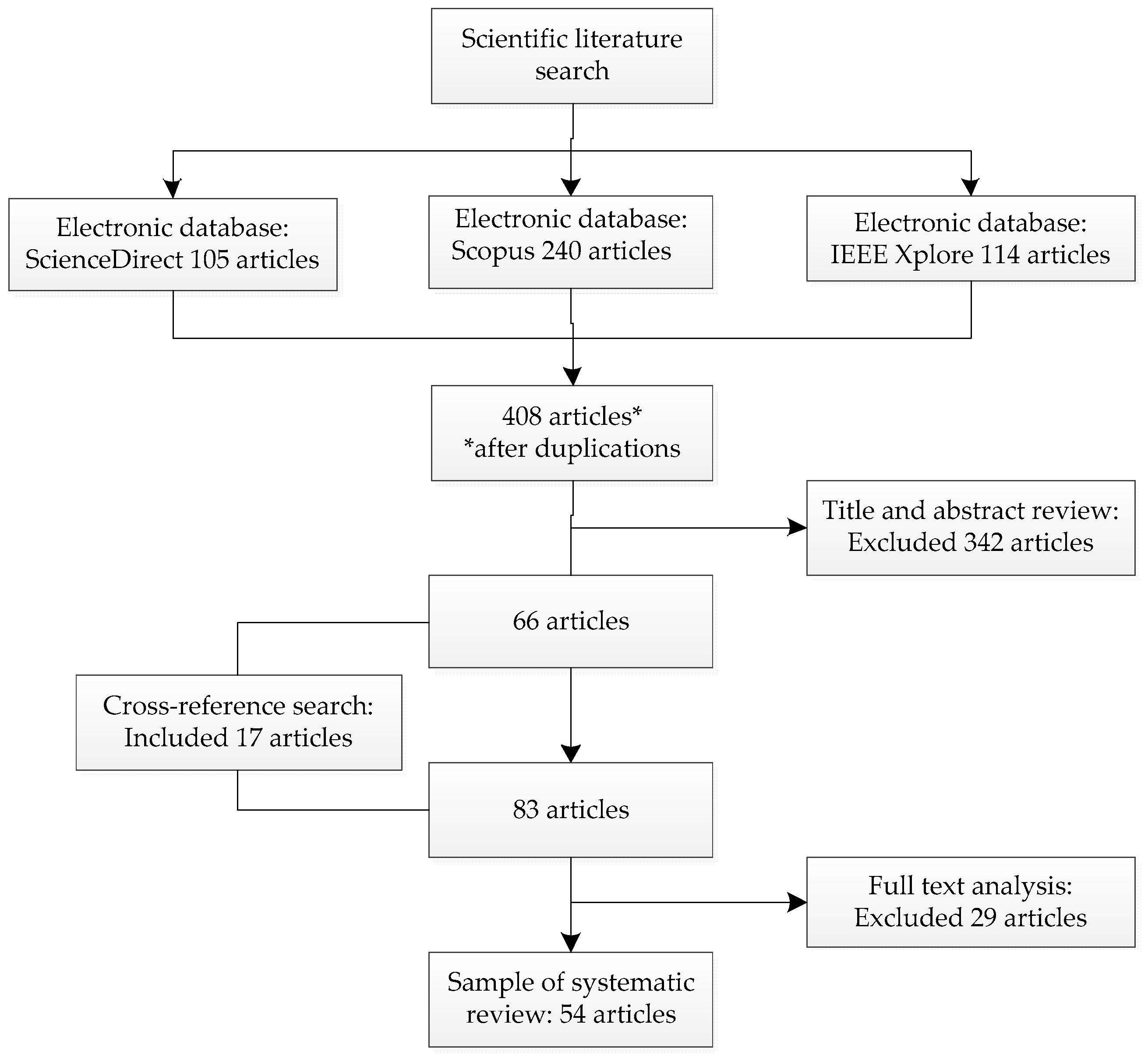
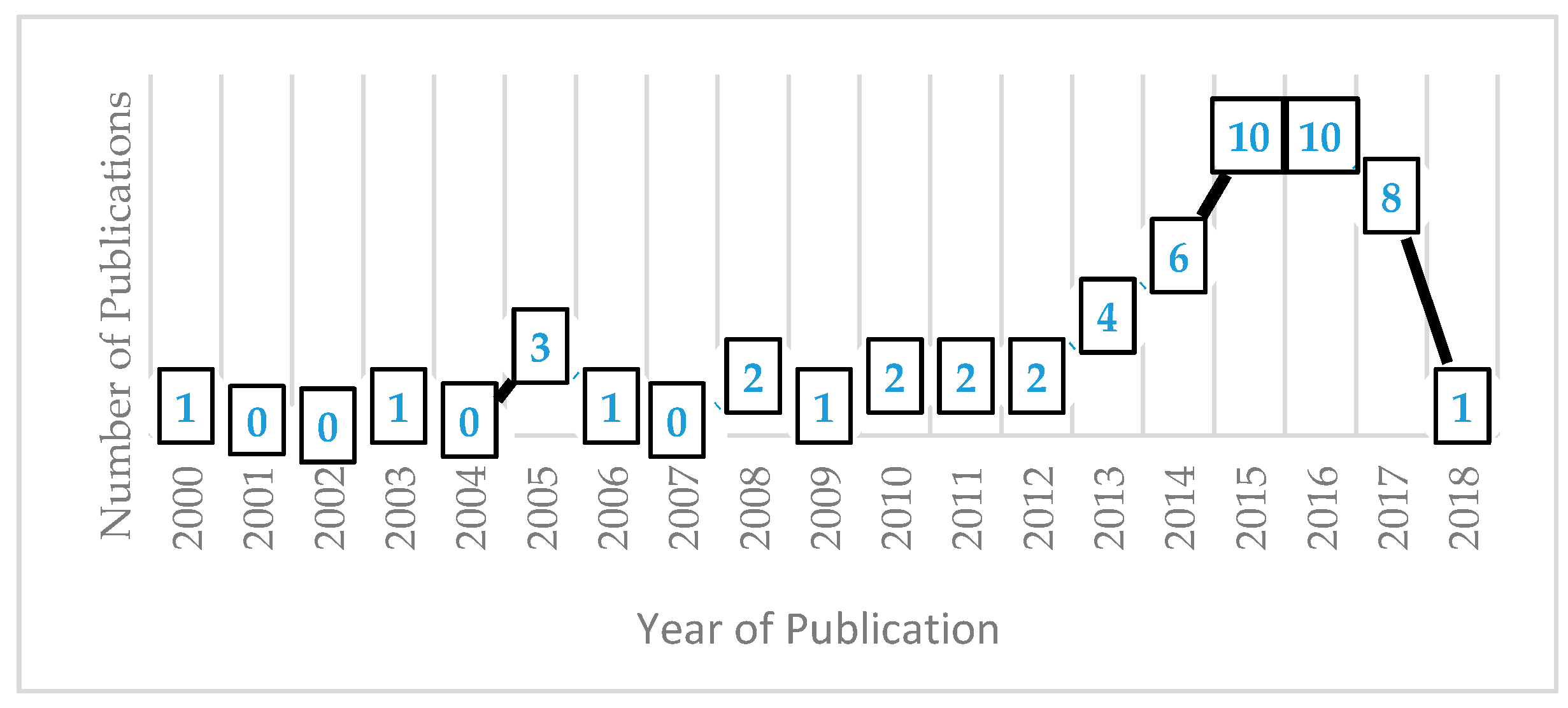

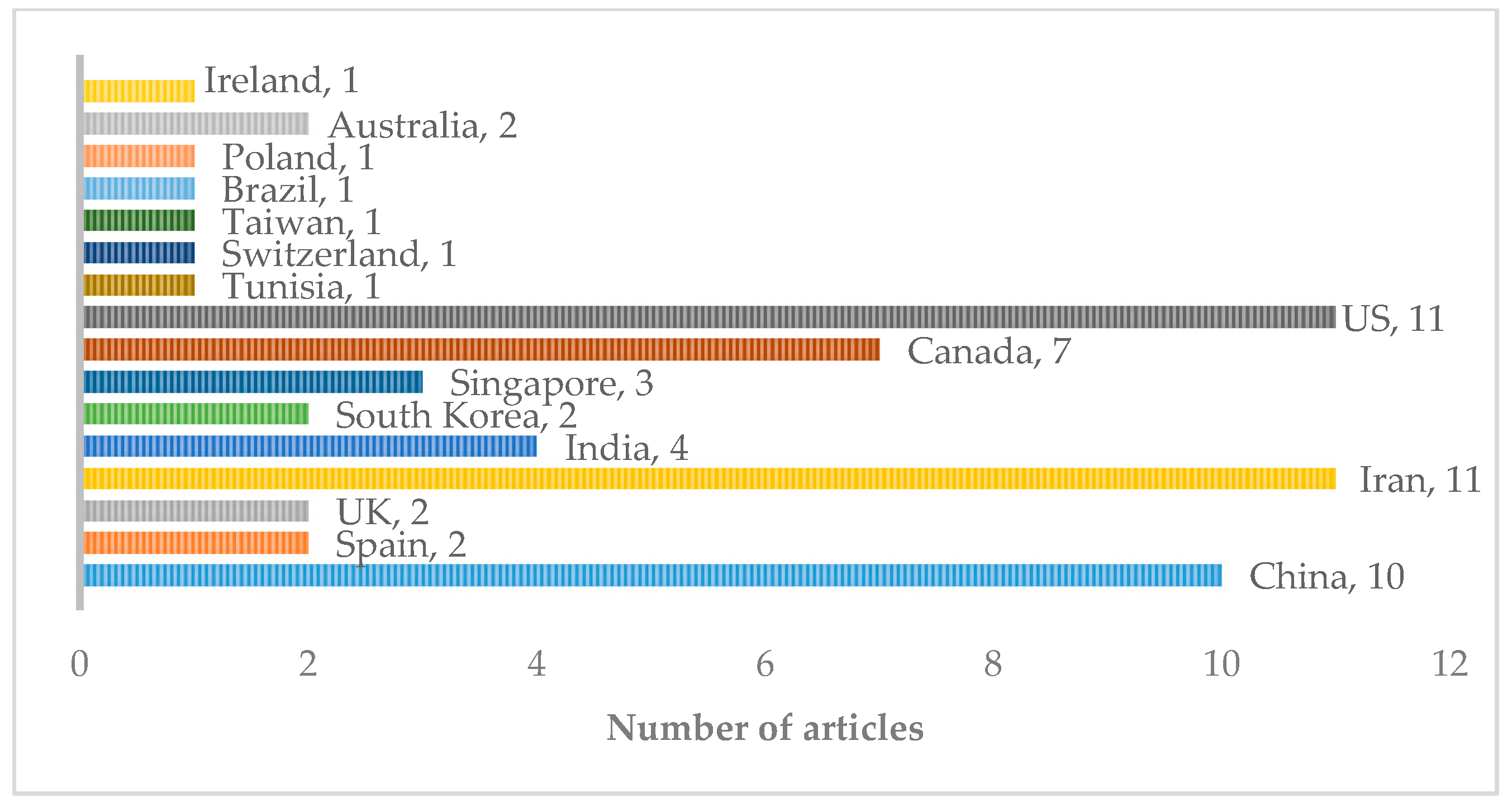
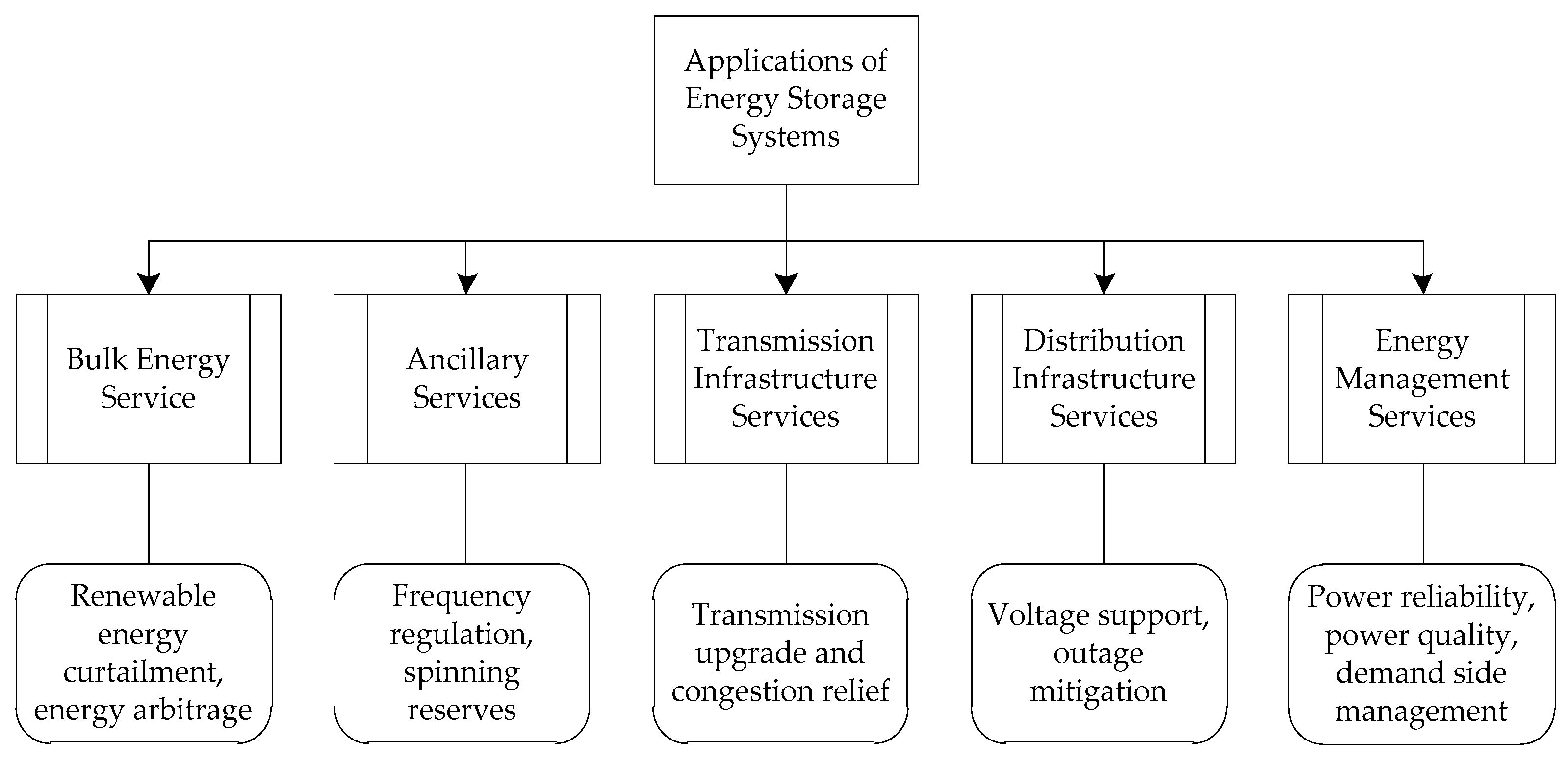
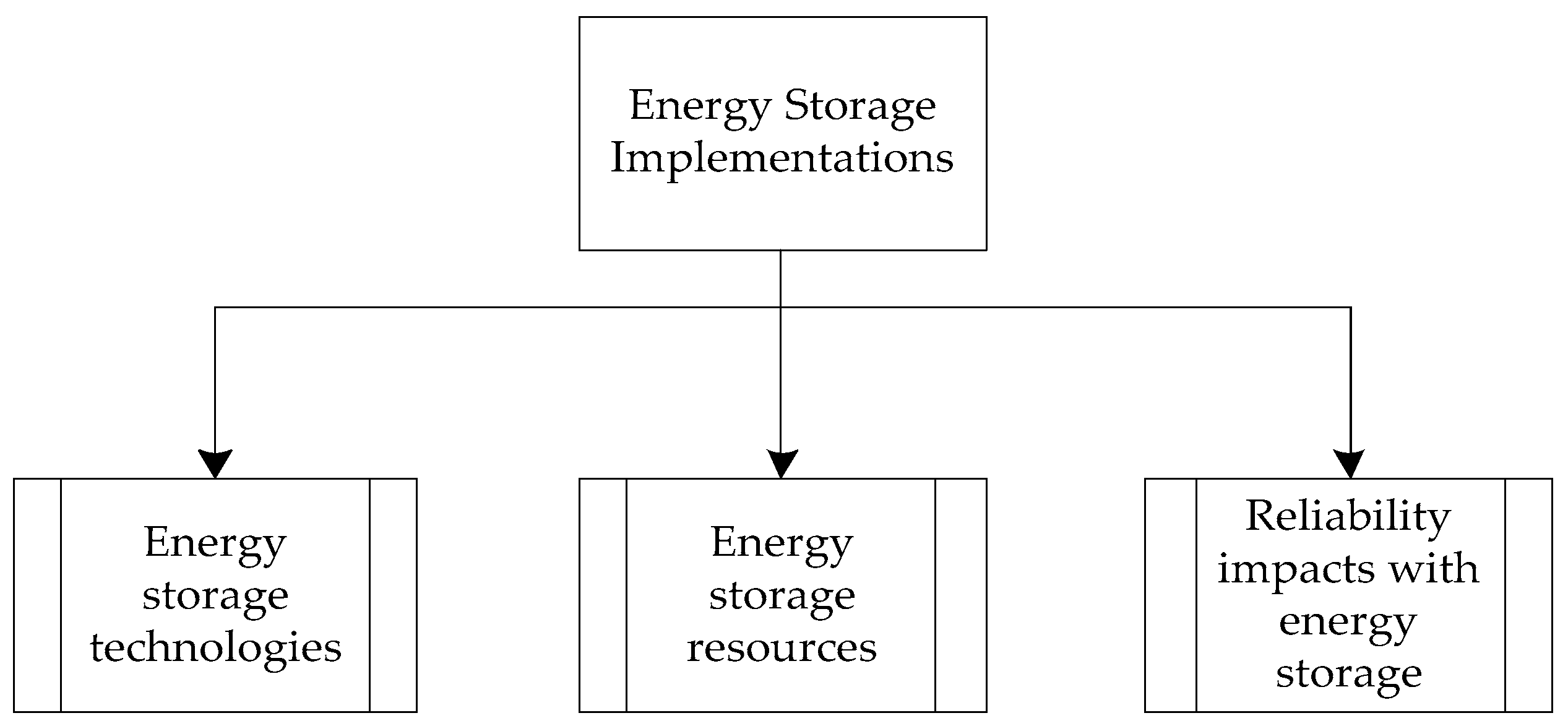
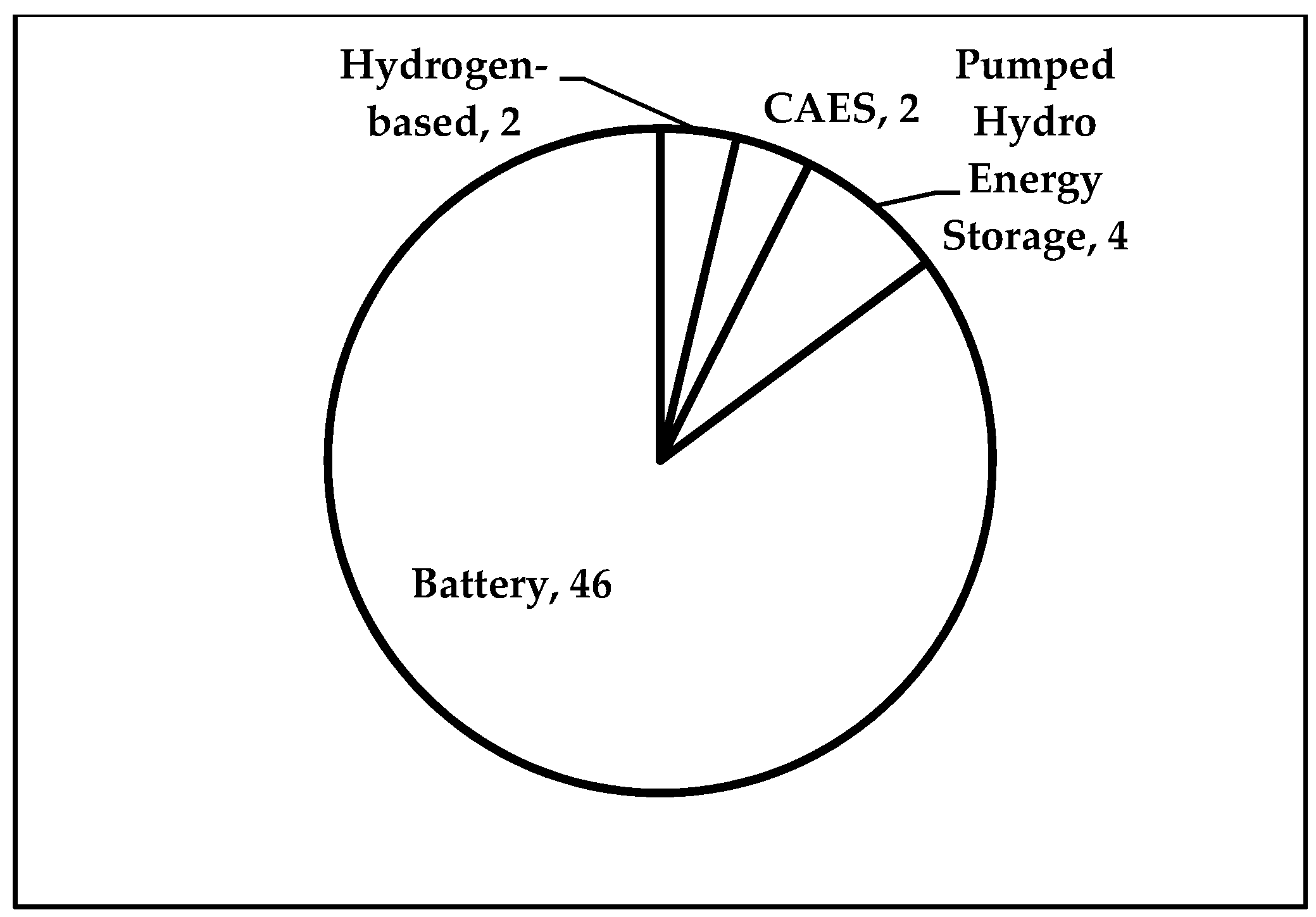
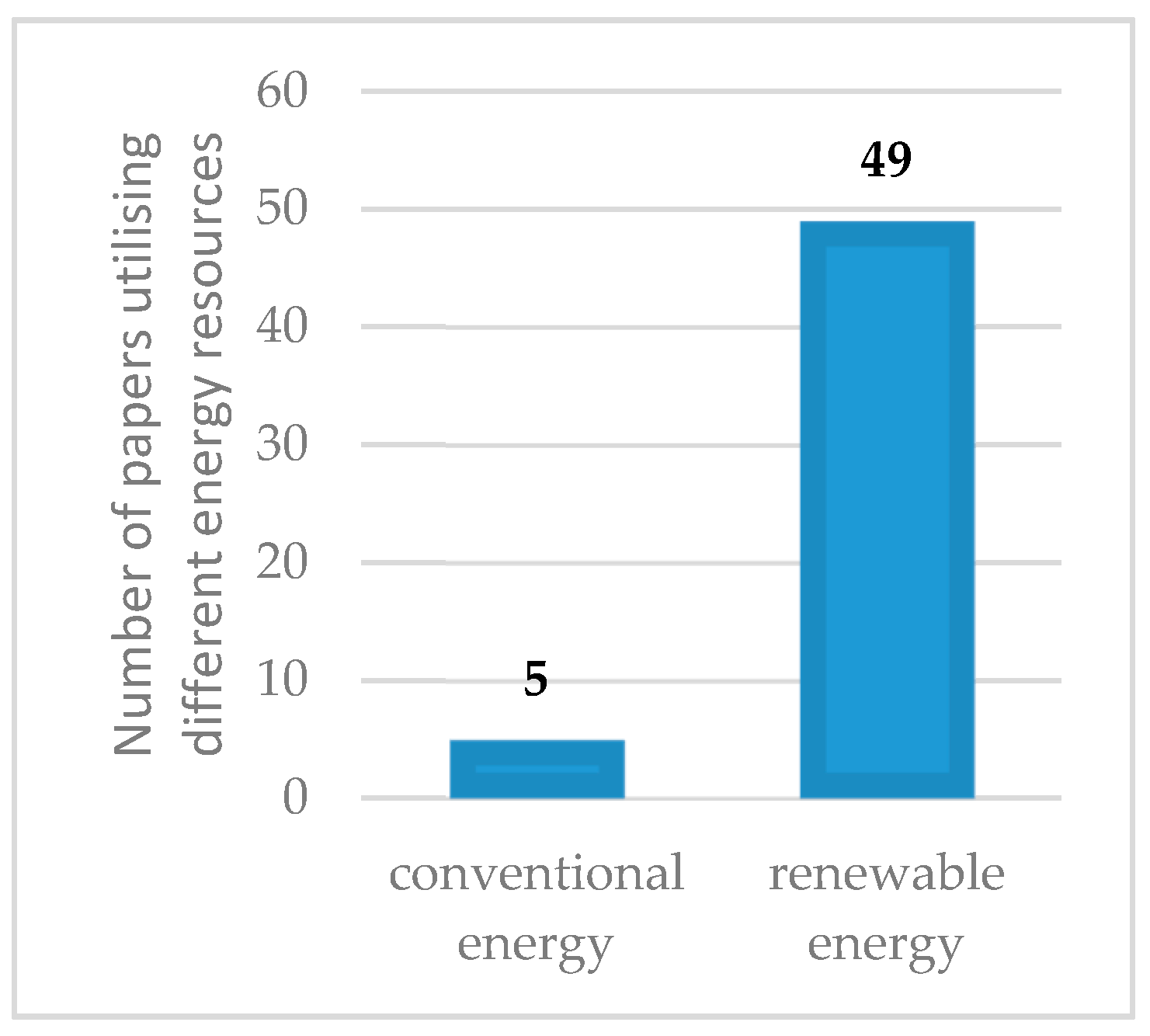
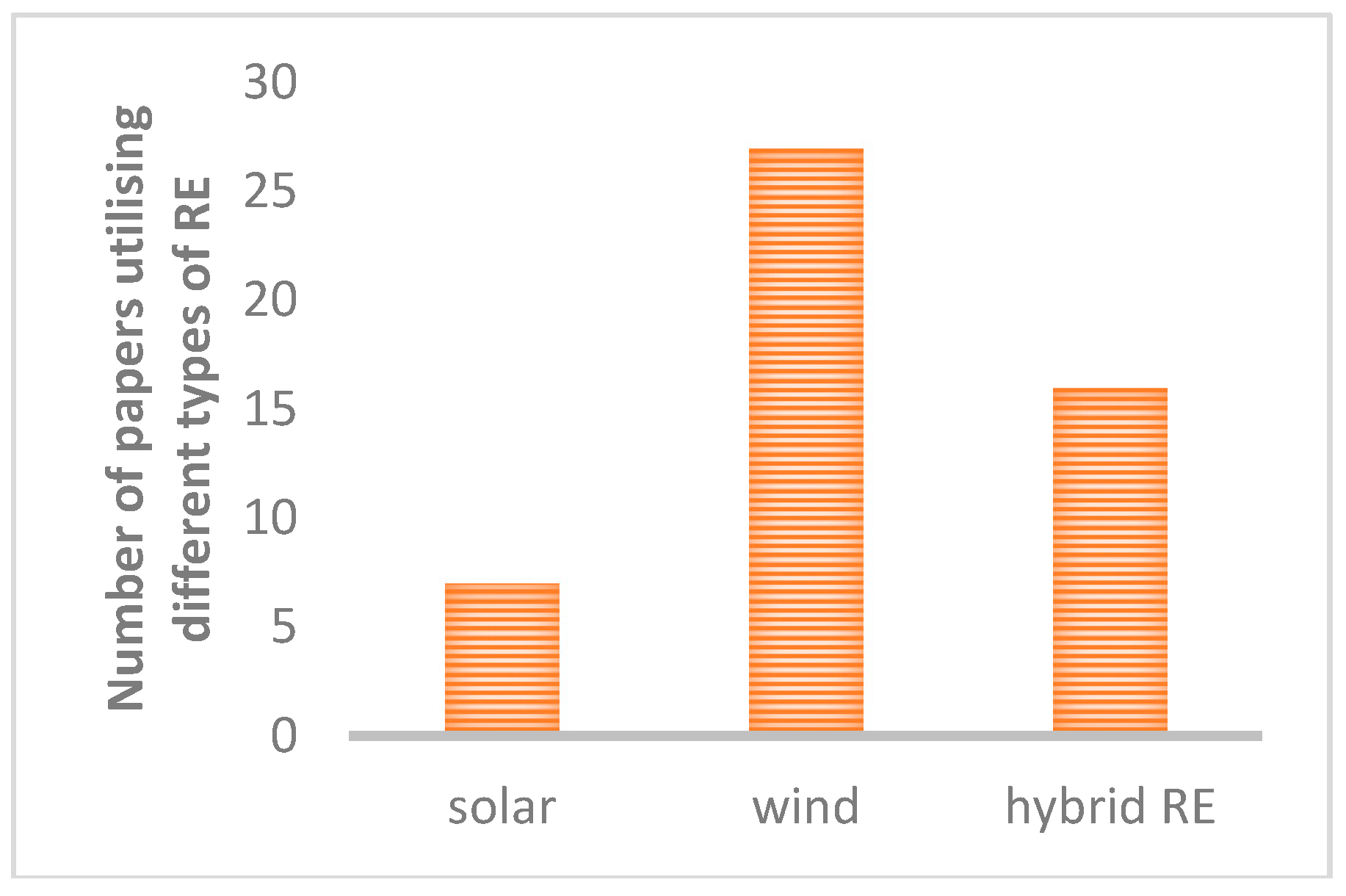
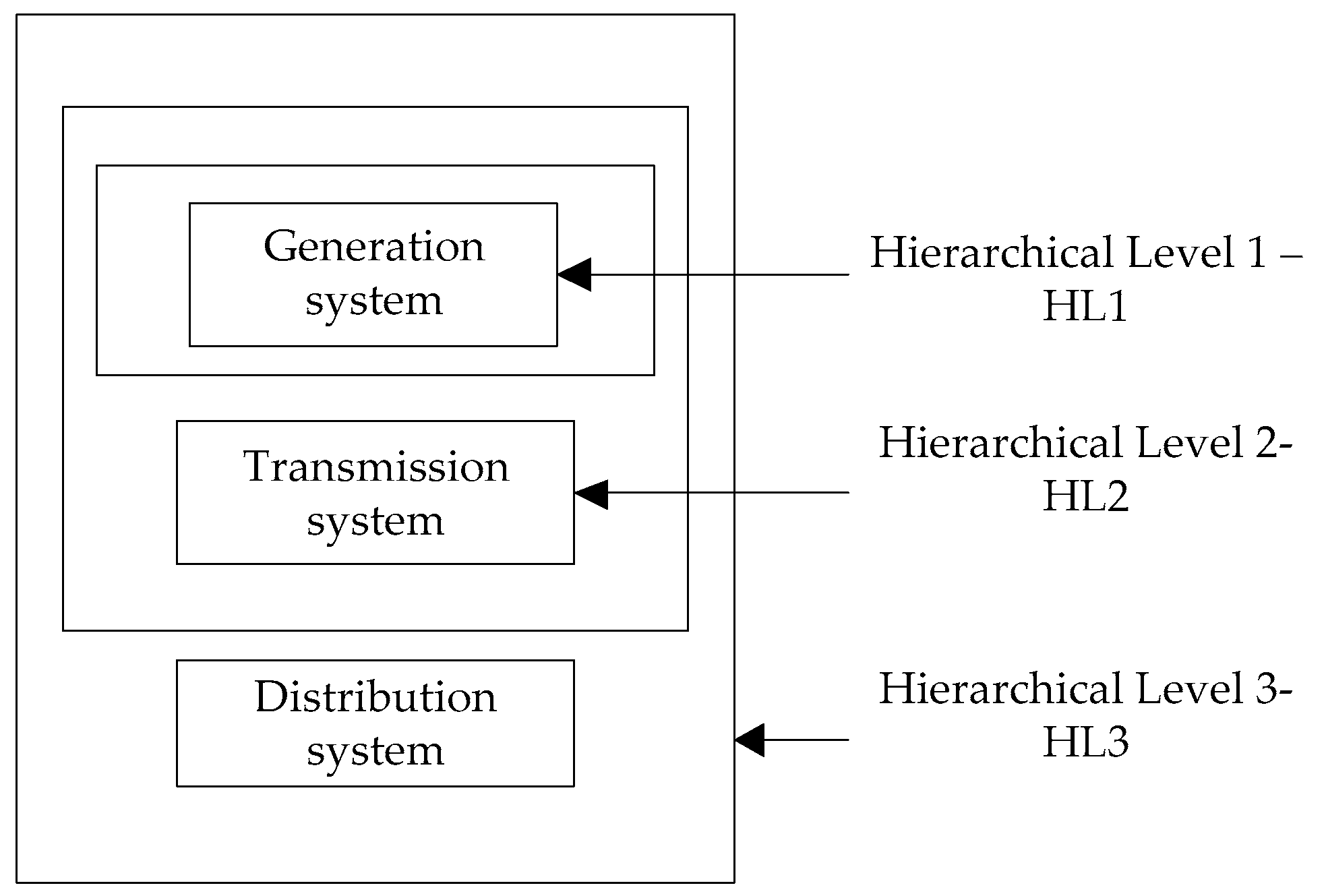
| Issue | Inclusion Criterion |
|---|---|
| Publication type | Peer-reviewed publications |
| Language | English |
| Availability | Available online as full text |
| Research discipline | Energy, energy conversion, and management and engineering |
| Research methodology | Empirical |
| Time period | 1996–2018 |
| Sector | Power system |
| Relevance | Article addresses integration of energy storage systems to promote reliability of power systems |
| Journal | Number of Articles |
|---|---|
| IEEE Transaction on Sustainable Energy | 10 |
| Energy | 9 |
| Renewable Energy | 4 |
| Journal of Modern Systems and Clean Energy | 4 |
| IEEE Transactions on Smart Grid | 3 |
| IEEE Transactions on Energy Conversions | 3 |
| Others | 4 |
| Conference | Number of Articles |
|---|---|
| IFAC | 3 |
| Probabilistic Methods Applied to Power Systems | 3 |
| Others | 5 |
| Power System Network | Number of Applications |
|---|---|
| Transmission Network | 15 |
| Distribution Network | 18 |
| Micro-grid | 21 |
| Energy Storage | Descriptions |
|---|---|
| Supercapacitor energy storage | Supercapacitors store electrical energy directly and thus do not need to convert to other energy forms. |
| Superconducting magnetic energy storage systems (SMESs) | SMESs store electrical energy in the form of an electromagnetic field. |
| Flywheels | The flywheel stores energy in the form of mechanical energy. |
| Batteries | Energy is chemically stored. |
| Fuel cells | Electricity is generated through a reverse electrochemical reaction. |
| Thermal energy storage systems | Thermal energy is converted from electrical energy; the storage medium can be solid or liquid. |
| Pumped hydroelectric storage | Storage depends on the gravitational height between upper and lower reservoirs and work by potential energy. |
| Compressed air energy storage (CAES) | A CAES is an electromechanical device that produces electrical energy converted from mechanical energy. |
| Source | Contribution | Benefit(s) | Limitation(s) |
|---|---|---|---|
| [20] | Reliability assessment of ESS in isolated solar power system | Applies Markov chain method, which has shorter computational time than do Monte Carlo simulations | Does not specify utilization of forced outage rate of system components |
| [23] | Determination of unit commitment of a power system with pumped storage | Discusses and differentiates capacity credit of a storage system from a conventional unit system | Does not consider uncertainty caused by wind farm |
| [50] | Reliability assessment of contribution of ESS to integrated wind power system for Jeju Island | Considers the chronological nature of output wind power and ESS by employing sequential MCS | May extend research by optimally sizing ESS capacity to improve reliability |
| [51] | Investigation of reliability benefits of wind and hydro coordination | Proposes simulation method while extending energy-limited hydro system model | May extend research to determine optimal reservoir capacities to improve system reliability and reduce costs |
| [52] | Investigation of the reliability of a system when coal-fired power stations are being replaced with renewable energies | Analytically verifies possibility of installing large share of wind generation by incorporating PHES | May extend research by considering the effect of varying storage capacities on system |
| [53] | Investigation of ESS in integrated wind power system using analytical method | Defines a new index (‘expected energy not used’) to present energy wasted in wind farm | May extend research by optimally locating and sizing ESS to further improve reliability |
| Source | Contribution | Benefit(s) | Limitation(s) |
|---|---|---|---|
| [27] | Presents a stochastic method to maximize daily profit of a system containing renewable energy | Adopts stochastic dynamic programming to obtain optimal operation of ESS on the basis of wind energy time shifting | Does not specify utilization of forced outage rate of system components |
| [54] | Applies reliability assessment to determine adequate size of ESS and need for transmission upgrade | Evaluates different transmission line capacities to demonstrate reliability impacts; states that ESS can delay transmission line upgrade | Does not specify utilization of forced outage rate of system components |
| [55] | Utilizes loss of power supply probability (LPSP) to determine system reliability | Optimizes size of wind–solar capacity using LPSP | Does not specify utilization of forced outage rate of system components |
| [56] | Evaluates reliability impact of utilizing ESS with proposed intelligent operating strategy | Coordinates transmission and distribution network to ESS in parallel to relieve transmission congestion | May extend research in cost–benefit analysis while considering customer interruption costs |
| [57] | Evaluates impacts of pumped hydro energy storage against transmission line expansions | Applies multi-objective framework that considers different types of costs | The proposed planning method is intended for future expansion of 10 years to come; therefore, future study may consider the fact that the prices of each cost component can change. |
| [58] | An ESS is optimally scheduled considering system reliability | Expresses change in discretized SOC battery level on the basis of dynamic programming | May extend further research to optimally determine the size of ESS, which can improve total costs and reliability |
| [34] | Presents multi-stage generation expansion planning (GEP) and ESS scheduling | Expresses GEP-ESS planning as nonlinear optimization problem solved by PSO to minimize total costs of system and environmental pollution | Does not specify utilization of forced outage rate of system components |
| [28] | Presents a probabilistic optimal power flow to optimally size and locate ESS and thus minimize the cost of operations and interruptions | Proposes a stochastic framework to evaluate reliability of a system consisting of renewable energy resources and ESS | Does not consider fluctuating costs of conventional generation |
| Source | Contribution | Benefit(s) | Limitation(s) |
|---|---|---|---|
| [60] | Solves energy dispatch problem in a smart grid consisting of renewable energy sources and ESS | Adopts economic model predictive control to optimize economic costs | Does not specify utilization of forced outage rate of system components |
| [61] | Proposes integration of tactical and operational management of a micro-grid | Uses sample-average approximation (SAA) to optimally improve reliability and system profit | Does not specify utilization of forced outage rate of system components |
| [62] | Presents a cost–benefit analysis in active distribution system | Applies single PSO to identify optimal ESS siting and system net profit | Does not specify how solar power is modelled |
| [31] | Integrates the use of RTTR alongside ESS to increase the availability of ESS and improve reliability | Presents a probabilistic approach of a demand and operational constraints of the ESS | May extend research to optimally locate RTTR and thus further improve reliability |
| [63] | Reliability evaluation of integrated renewable energy with electric vehicle (EV) operating strategy | Investigates the impact of EV parking lots on system reliability during outage events due to variability output power of renewable energy | Applies non-sequential Monte Carlo simulation, which does not consider the intermittency of renewable energy |
| [47] | Assessing reliability contribution of ESS in hybrid tidal–wave integrated power system | Derives reliability model of an ESS and converters | May extend research by including the effect of manipulating ESS capacity on the system |
| [64] | Adopts cuckoo search to optimally size a micro-grid component while minimizing costs | Compares its performance with other optimization algorithms | May extend research by optimally locating ESS to improve reliability |
| [65] | Presents an optimization of storage reserve sizing to minimize total costs | Adopts Markovian steady-state sizing method, which has smaller computational time consumption than Monte Carlo simulation | Does not specify utilization of forced outage rate of system components |
| [43] | Presents a probabilistic approach to determine adequacy in small solar system | Considers the impact of per minute ramp rates to accurately model load demand | May extend research by optimally sizing the capacity of ESS to improve reliability |
| [66] | Proposes the reliability benefits of mobile BESS in distribution network | Compares analytical and simulation methods to verify result accuracy | May include sensitivity studies, such as those considering the effect of wind penetration level on the system |
| [67] | Presents PSO to optimally size system components to minimize net cost of a micro-grid | Distinguishes interruptible and uninterruptible loads, which is practical for distribution network | May extend further research to include the effect of ESS siting on bus nodes on system reliability |
| [40] | Solves optimization problem of ESS sizing and siting while minimizing total system costs | Proposes a probabilistic technique which considers uncertainty of system components | May extend future research by considering fluctuating costs of diesel |
| [68] | Presents an optimal sizing solution for ESS serving a stand-alone wind power system | Considers battery’s charge/discharge current and cycles to analyze their effects on battery’s lifetime | Does not specify utilization of forced outage rate of system components |
| [69] | Presents a stochastic approximation method to size a hybrid system component. | Uses pattern search to optimize sizing | May extend further research to include the effect of ESS siting on bus nodes on system reliability |
| [41] | Proposes an analytical model for reliability evaluation of ESS while optimally minimizing system present cost using genetic algorithm | Includes battery lifetime consideration on the basis of Ah throughput aging model | Does not consider fluctuating costs of diesel |
| [41] | Presents an optimization technique to size a stand-alone solar system consisting of PV panels and batteries | The technique utilizes statistical modelling of the solar radiation. | Does not specify utilization of forced outage rate of system components |
| [70] | Integrates a distribution network with the use of ESS and dynamic network reconfiguration | Proposes operating strategy of ESS to smooth out the variability of wind generation and increase the reliability | Does not specify utilization of forced outage rate of system components |
| [71] | Presents an innovative operating strategy that is based on MPC | Distribution network is modelled according to several segments; from upward to downward | May extend future work by optimally size the wind and ESS capacity to improve reliability and costs of the system |
| [72] | Proposes different operating strategies of diesel with ESS back-up | Proposes solution by making renewable energy as the priority to serve load; reduces the demand for diesel | Does not specify battery constraints, such as charging/discharging constraints and maximum/minimum capacity to be stored |
| [73] | Determines economic point of how much wind energy can be integrated to the system while improving reliability | Describes probabilistic production costing of a wind–diesel conversion system | Does not specify the constraints of ESS, such as the maximum rate of charging and discharging constraints |
| [74] | Presents a multi-objective approach to minimizing operation costs while improving reliability of a distribution network | The proposed algorithm is able to converge to the optimal solution rapidly, producing the lowest cost and good reliability improvement. | Does not specify utilization of forced outage rate of system components |
| [75] | Presents stochastic capacity expansion planning of a micro-grid to reduce capital cost of a project | Considers operational and investment costs while satisfying reliability constraint | For future research, ESS expansion may include associated cost such as equipment transportation each time system is upgraded. |
| [32] | Applies mixed-integer linear planning to integrate ESS in multi-stage distribution network planning | Improves economic operation based on hourly variable electricity price on substation nodes | Does not specify utilization of forced outage rate of system components |
| [76] | Evaluates a reliability-constrained optimal ESS sizing in a micro-grid | Applies Monte Carlo simulation that considers uncertainties along with the optimization scheme | May extend further research to include the effect of ESS siting on bus nodes on system reliability and operational costs |
| [77] | Presents energy dispatch solutions for autonomous micro-grids by incorporating power loss and reliability statistics | Applies ‘stem–leaves’ approach to optimize energy dispatch across connected micro-grids | Does not specify utilization of forced outage rate of system components |
| [78] | Integrates demand response program with ESS to reduce total costs and improve reliability | Proposes DRP to optimally size and locate ESS in the micro-grid to improve economic benefit. | Does not specify the constraints of the ESS, such as the maximum charging and discharging rate of the battery |
| [33] | Optimization of ESS sizing and siting for reliability improvement in distribution network | Optimizes the cost of ESS while minimizing the cost of interruptions | May extend further research by optimally locating ESS to improve reliability |
| [79] | Proposes a dispatch strategy to determine ESS capacity | Considers uncertainties in wind speed and load | For future research, unit operational constraints can be added. |
| [80] | Optimizes the total cost of the system and cost of energy not supplied | Proposes a stochastic power flow to model uncertainty of wind turbine, PV panels and charging/discharging pattern of EVs | Does not specify utilization of forced outage rate of system components |
| [26] | Multi-objective PSO is applied to minimize costs and reliability indices of the system. | Outages of PV arrays, wind turbines, and converters are also considered | Does not consider the uncertainty in wind speed, solar radiation and load data demand |
| [81] | Presents an optimal expansion planning for grid-connected micro-grid which aims to maximize reliability and minimize costs | Proposes a real-time energy exchange with the utility on the basis of tariff variability | In future work, several solutions can be implemented to solve ILP over-estimate of solution bounds. |
| [48] | Proposes operating strategies for supply-adequate micro-grids considering real and reactive power | Uncertain characteristics of distribution generation units and loads are considered | Does not specify the constraints of ESS, such as the maximum rate of charging and discharging constraints |
| [36] | Investigates the impacts of ESS on power systems utilizing wind and/or solar energy | Proposes a sequential MCS, recognizing the time-varying nature of renewable energy power output | Does not specify the constraints of the ESS, such as the maximum charging and discharging rate of the battery |
| [82] | Analyses the contribution of ESS to reliability of solar power system | Considers behavior of solar irradiance and outages due to hardware failure | Applies non-sequential Monte Carlo simulation, which does not recognize fluctuations of generated power |
| [83] | Evaluates reliability of a hybrid solar–wind isolated power system with ESS | Proposes discrete speed frame analysis to model wind speed | Does not consider maintenance and repair characteristics of system components |
| [84] | Calculates the sizing of batteries on the basis of loss of load probability | Analyzes the impact of increase in peak demand on the system | Applies non-sequential Monte Carlo simulation, which does not recognize fluctuations in generated power |
| [85] | Proposes a simulation method which extends well-being analysis to renewable energy generation | Considers different energy compositions and storage capacity levels | Does not specify the constraints of the ESS, such as the maximum charging and discharging rate of the battery |
| [35] | Evaluates reliability impact of EVs under battery exchange (BE) mode | Defines a new index to quantify interruption effects on users (‘user demand not satisfied’) | May extend future research by optimally sizing BE station capacity to improve reliability among users and utility’s point of view |
| [86] | Proposes cost/worth evaluation of generating system consisting of wind energy and ESS | Presents a new approach that considers utility and cost interruptions in the evaluation | Does not consider fluctuating costs of diesel |
| [13] | Evaluates reliability of micro-grid consisting of renewable energy generation and ESS | Islanding mode is incorporated on the basis of the probabilities of switching process quality indicators. | Applies non-sequential Monte Carlo simulation, which does not satisfy the chronological nature of solar output power |
© 2018 by the authors. Licensee MDPI, Basel, Switzerland. This article is an open access article distributed under the terms and conditions of the Creative Commons Attribution (CC BY) license (http://creativecommons.org/licenses/by/4.0/).
Share and Cite
Mohamad, F.; Teh, J. Impacts of Energy Storage System on Power System Reliability: A Systematic Review. Energies 2018, 11, 1749. https://doi.org/10.3390/en11071749
Mohamad F, Teh J. Impacts of Energy Storage System on Power System Reliability: A Systematic Review. Energies. 2018; 11(7):1749. https://doi.org/10.3390/en11071749
Chicago/Turabian StyleMohamad, Farihan, and Jiashen Teh. 2018. "Impacts of Energy Storage System on Power System Reliability: A Systematic Review" Energies 11, no. 7: 1749. https://doi.org/10.3390/en11071749
APA StyleMohamad, F., & Teh, J. (2018). Impacts of Energy Storage System on Power System Reliability: A Systematic Review. Energies, 11(7), 1749. https://doi.org/10.3390/en11071749






